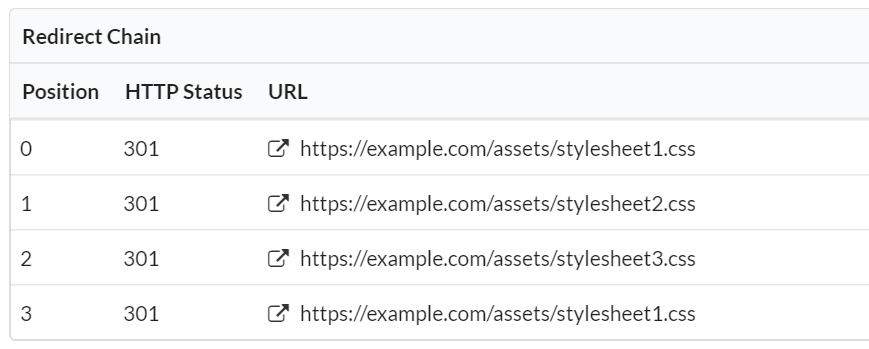Page resource URL is part of a chained redirect loop
This means that the URL is question is a page resource URL that is part of a redirect chain which results in a redirect loop (e.g. URL 1 -> URL -> 2 -> URL 3 -> URL 1), which results in the resource being inaccessible.
Why is this important?
A redirected URL, typically 301 (permanent) or 302 (temporary) means that the location of the page has changed, and the user is sent from the original URL to a new one. With a chained redirect loop, there are a number of URLs that each redirect in a chain, which eventually loops back around to the 'first' URL.
In this case, the URL in question is a page resource URL (e.g. Image URL or JavaScript file), which means it is used for rendering the content on a page. If the resource is no longer accessible, this may affect how it is rendered, which could cause a poor user experience.
What does the Hint check?
This Hint will trigger for any page resource URL which is part of a chained redirect loop.
Examples that trigger this Hint:
Consider the resource URL: https://example.com/css/body.css
The Hint would trigger for any URL if it returned a 3XX HTTP header response;
HTTP/... 301 Moved Permanently
...
Location: https://example.com/css/body2.css...
that is part of a redirect chain, so https://example.com/css/body2.css also redirects;
HTTP/... 301 Moved Permanently
...
Location: https://example.com/css/body3.css...
and then https://example.com/css/body2.css also redirects, back to the original URL:
HTTP/... 301 Moved Permanently
...
Location: https://example.com/css/body.css...
How do you resolve this issue?
If you have issues with page resource URLs, this could mean that page content is not rendering correctly, which may be providing a poor experience for website visitors. Further, search engines like Google are moving towards being 'render-first', and if they are unable to access resources necessary for rendering, this may affect how the content is indexed.
Chained redirects add a further complication, as multiple URLs are involved. As such, resolving such as problem requires a number of steps:
- Unpick the redirect chain, so you understand all the different redirecting URLs.
- Make the resource available on a URL that serves a 200 (OK) HTTP response, to make the resource accessible.
- Update the URLs that reference this resource, making sure to check all the various redirecting URLs in the chain.
How do you get more data from Sitebulb?
In order to unpick the redirect chain (#1 above), you will need to see all the URLs in the chain. You can do this by clicking the blue URL Details button from the URL List, and scrolling to the Redirect Chain section on the Overview.

You will also need to locate the URLs referencing each resource (#3 above). You can find these by clicking on the grey View button from the URL List, under the column No. URLs Referencing Resource.

 Sitebulb Desktop
Sitebulb Desktop
Find, fix and communicate technical issues with easy visuals, in-depth insights, & prioritized recommendations across 300+ SEO issues.
- Ideal for SEO professionals, consultants & marketing agencies.
 Sitebulb Cloud
Sitebulb Cloud
Get all the capability of Sitebulb Desktop, accessible via your web browser. Crawl at scale without project, crawl credit, or machine limits.
- Perfect for collaboration, remote teams & extreme scale.